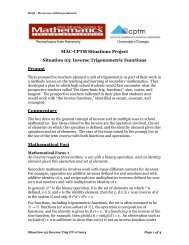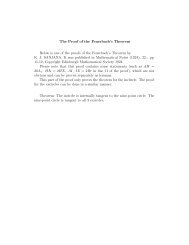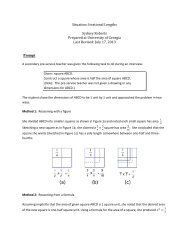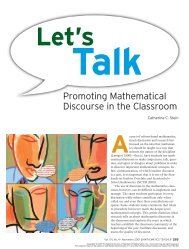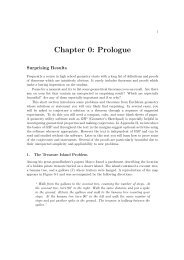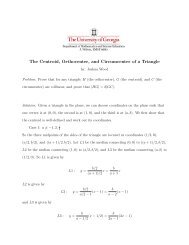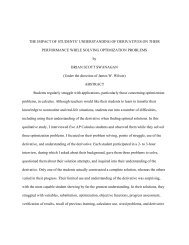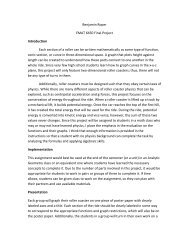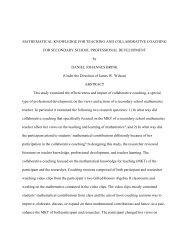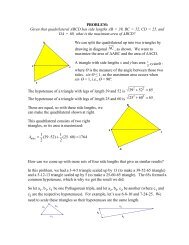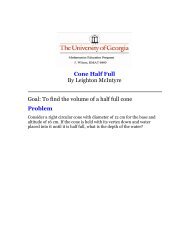Congruent Triangles vs. Similar Triangles - University of Georgia
Congruent Triangles vs. Similar Triangles - University of Georgia
Congruent Triangles vs. Similar Triangles - University of Georgia
- No tags were found...
You also want an ePaper? Increase the reach of your titles
YUMPU automatically turns print PDFs into web optimized ePapers that Google loves.
Situation 1: <strong>Congruent</strong> <strong>Triangles</strong> <strong>vs</strong>. <strong>Similar</strong> <strong>Triangles</strong>Prepared at the <strong>University</strong> <strong>of</strong> <strong>Georgia</strong> EMAT 6500Date last revised: July 24 th , 2013Nicolina ScarpelliPrompt:A teacher in a high school Analytic Geometry class is teaching a lesson on how to use congruence andsimilarity criteria for triangles to solve problems and to prove relationships in geometric figures. In the middle<strong>of</strong> the lesson a student asked, “What is the difference between congruent triangles and similar triangles?”Commentary:The set <strong>of</strong> mathematical foci below bring attention to the background knowledge that one must have inorder to understand the concepts <strong>of</strong> similarity and congruence. The first focus highlights the axiomatic approachtaken by Euclid and David Hilbert, which is ultimately the foundation <strong>of</strong> plane geometry. In order to grasp theconcept <strong>of</strong> congruence and similarity not only in triangles but also in other geometric figures, one must first befamiliar with the Euclidean distance formula derived from the Pythagorean Theorem (second focus). The otherthree foci that follow concentrate on proving congruence and similarity in triangles by using the geometricproperties <strong>of</strong> triangles and angles.Mathematical Foci:Focus 1: This focus highlights the congruence propositions presented in Euclid’s work along with thecongruence axioms <strong>of</strong> Plane Geometry developed by David Hilbert.Euclid’s “Elements” <strong>of</strong> geometry, written around 300 B.C. may be one <strong>of</strong> the most famous mathematical works<strong>of</strong> all time which served for thousands <strong>of</strong> years as a foundation <strong>of</strong> mathematics education. The “Elements” ismade up <strong>of</strong> 13 books which cover many different mathematical concepts from plane geometry to numbertheory. In book 1, Euclid developed the concept <strong>of</strong> congruence within the propositions listed below. However,he did not explicitly use the term “congruent” he rather used the word “equal”.Euclid’s Propositions <strong>of</strong> Congruence:Proposition 4: If two triangles have two sides equal to two sides respectively, and have the anglescontained by the equal straight lines equal, then they also have the base equal to the base, the triangleequals the triangle, and the remaining angles equal the remaining angles respectively, namely thoseopposite the equal sides. (Side – Angle – Side)Proposition 8: If two triangles have the two sides equal to two sides respectively, and also havethe base equal to the base, then they also have the angles equal which are contained by the equalstraight lines. (Side – Side – Side)Proposition 26: If two triangles have two angles equal to two angles respectively, and one sideequal to one side, namely, either the side adjoining the equal angles, or that opposite one <strong>of</strong> the equalangles, then the remaining sides equal the remaining sides and the remaining angle equals the remainingangle. (Angle – Angle – Side or Side – Angle - Angle)Euclid’s “Element’s” introduced the axiomatic method <strong>of</strong> geometry; however, there were many shortcomingswithin Euclid’s procedures. His work and ideas seemed to be somewhat incomplete, which lead David Hilbertto publish a new set <strong>of</strong> axioms and propositions in his book, “Grundlagen der Geometrie,” which translates to“Foundations <strong>of</strong> Geometry” and was published in 1898. Hilbert developed the following axioms <strong>of</strong> congruence:
Therefore, ∆!"# ≅ ∆!"# by the SAS Congruence PostulateAn important concept to remember is that the factor for congruent triangles is always equal to 1. For example,take a look at the Geometer’s Sketchpad example below. The corresponding sides are congruent and thecorresponding angles are congruent. In addition, the proportion <strong>of</strong> the corresponding sides is equal to 1.If you were to change the size and shape <strong>of</strong> a pair <strong>of</strong> triangles by dragging vertex B, C, or D, the correspondingangles (≮ ! ! , ≮ ! ! !"# ≮ ! ! ) would remain congruent. Since the sum <strong>of</strong> three angles must be 180° accordingto the Angle Sum Theorem, the third pair <strong>of</strong> corresponding angles must also be congruent when the first twopairs <strong>of</strong> corresponding angles are congruent.Triangle Congruence Theorems:1. Side – Side – Side (SSS): If three sides <strong>of</strong> one triangle are congruent to three sides <strong>of</strong> another triangle,then the triangles are congruent.Click here (http://www.youtube.com/watch?v=PqkVf0TR_1Y) for Euclid’s pro<strong>of</strong> <strong>of</strong> thisCongruence Theorem2. Side – Angle – Side (SAS): If two sides and the included angle <strong>of</strong> a triangle are congruent to two sidesand the included angle <strong>of</strong> another triangle, then the two triangles are congruent.Click here (http://www.youtube.com/watch?v=sk2dL_kitcE) for Euclid’s pro<strong>of</strong> <strong>of</strong> thisCongruence Theorem
3. Angle – Side – Angle or Side – Angle – Angle (ASA or SAA): if two angles and the included side <strong>of</strong>one triangle are congruent to two angles and the included side <strong>of</strong> another triangle, then the triangles arecongruent. (The included side is the side between the vertices <strong>of</strong> the two angles.)Click here (http://www.youtube.com/watch?v=S-io0P5_YWA) for Euclid’s pro<strong>of</strong> <strong>of</strong> thisCongruence Theorem4. Hypotenuse – Leg (HL): If the hypotenuse and leg <strong>of</strong> one right triangle are congruent to the hypotenuseand leg <strong>of</strong> another right triangle, the two triangles are congruent. It is important to remember that thispostulate only applies to right triangles!Click here (http://www.youtube.com/watch?v=-x-raNlGjMo) to learn more about theHypotenuse – Leg Congruence TheoremTriangle Non – Congruencies:1. Angle – Angle – Angle (AAA) is not a congruency theorem.Pro<strong>of</strong>: Look at the following equilateral triangles shown in the figure below:All three triangles are equilateral triangles, so they all have the same angles (each angle is 60 degrees), butthey are not congruent because they have different side lengths. The blue triangle has a side length <strong>of</strong> 3, thered triangle has a side length <strong>of</strong> 5, and the pink triangle has a side length <strong>of</strong> 7.2. Side – Side – Angle (SSA) is not a congruency theorem.Pro<strong>of</strong>: Let’s begin by drawing a ray !", and a segment !" with a fixed angle !.Then construct a circle centered at C using a radius such that circle intersects ray AB in two places. Labelthe points <strong>of</strong> intersections D and E.
Draw segments !", !", and !".Notice that using the radius <strong>of</strong> the circle, !" ≅ !". Now, let’s redraw the triangles as shown below:Notice that ADC is an obtuse triangle. We know angle A is congruent to angle A because it was a fixedangle from the beginning, and we know AC is congruent to AC because it was also a fixed side. Now, sinceCE is a radius <strong>of</strong> the circle, it must be congruent to CD. However, we have created two different triangles.Thus, SSA is ambiguous, because it does not give you enough information to determine that the trianglesare exactly the same. This is essentially a counterexample, thus, showing that SSA is not a congruencytheorem.
Focus 4: Defining Congruence in terms <strong>of</strong> rigid motions.In the field <strong>of</strong> Euclidean geometry, rigid motion is any combination <strong>of</strong> reflection, translation, androtation preserving angle measure and side length. These transformations are known as congruencetransformations because they alter a set <strong>of</strong> points in some way, but the points’ relationship with one anotherstays the same. Thus, there exists an isometry between the pre – image and the image. Thus, the image createdafter a transformation takes place is congruent to the pre – image. However, dilation is not an isometry since iteither shrinks or enlarges a figure, so it does not preserve angle measure or side length.Translations in the Coordinate Plane:Properties <strong>of</strong> Translations:• Translated figures are congruent to the original figure (In the example shown above, ∆!"# ≅ ∆!′!′!′)• Angles translate to congruent angles:(≮ !"# ≅≮ ! ! ! ! ! ! , ≮ !"# ≅≮ ! ! ! ! ! ! , !"# ≮ !"# ≅≮ ! ! ! ! ! ! )• Line segments (side lengths) translate to congruent line segments:(!" = !′!′, !" = !′!′, !"# !" = !′!′)Reflections in the Coordinate Plane:
The concept <strong>of</strong> distance can be applied with reflections since the line <strong>of</strong> reflection (in this example they – axis is the line <strong>of</strong> reflection) is equidistant from both A and A’, B and B’, and C and C’. Thus, the line <strong>of</strong>reflection is directly in the middle <strong>of</strong> every point on each triangle. Thus, the pre – image is always the samedistance away from the line <strong>of</strong> reflection as the image.Properties <strong>of</strong> Reflections:• Reflected figures are congruent to the original figure (In the example shown above, ∆!"# ≅ ∆!′!′!′)• Angles translate to congruent angles:(≮ !"# ≅≮ ! ! ! ! ! ! , ≮ !"# ≅≮ ! ! ! ! ! ! , !"# ≮ !"# ≅≮ ! ! ! ! ! ! )• Line segments (side lengths) translate to congruent line segments:(!" = !′!′, !" = !′!′, !"# !" = !′!′)Rotations in the Coordinate Plane:Triangle BCD has been rotated 180 degrees counterclockwise about the origin.Properties <strong>of</strong> Rotations:• Rotated figures are congruent to the original figure (In the example shown above, ∆!"# ≅ ∆!′!′!′)• Angles translate to congruent angles:(≮ !"# ≅≮ ! ! ! ! ! ! , ≮ !"# ≅≮ !′! ! ! ! , !"# ≮ !"# ≅≮ ! ! ! ! ! ! )• Line segments (side lengths) translate to congruent line segments:(!" = !′!′, !" = !′!′, !"# !" = !′!′)Focus 5: The Concept <strong>of</strong> <strong>Similar</strong>ity: <strong>Triangles</strong> are similar if they have the same shape, but not necessarily thesame size.Non –Rigid Transformation: Dilations in the Coordinate PlaneA dilation enlarges or reduces the size <strong>of</strong> a figure; thus, the pre – image and image <strong>of</strong> a dilation are notcongruent, but they are similar. A dilation <strong>of</strong> scalar factor k whose center <strong>of</strong> dilation is the origin may be writtenas: ! ! !, ! = (!", !"). If the scale factor, k, is greater than 1, the image is an enlargement or a stretch. If thescale factor, k, is between 0 and 1, the image is a reduction or a shrink.
In the above figure, triangle XYZ has been dilated by a scale factor <strong>of</strong> 2 to create triangle X’Y’Z’.Properties <strong>of</strong> dilation:1) Angle measures remain the same and are congruent under a dilation.(i.e ≮ !"# ≅≮ !′!′!′, ≮ !"# ≅≮ ! ! ! ! ! ! , !"# ≮ !"# ≅≮ !′!′!′)2) Distance is not preserved. Thus, a dilation is not an isometry because the lengths <strong>of</strong> the sides <strong>of</strong> thetriangle (or the lengths <strong>of</strong> the segments) are not equal.The above triangles are similar triangles. They are two triangles with three identical angles but not necessarilyidentical lengths. However, if they are not identical lengths they must have an identical scale factor for eachside.Properties <strong>of</strong> <strong>Similar</strong> <strong>Triangles</strong>:1) Corresponding angles are congruent2) Corresponding sides are all in the same proportionHow to determine if triangles are similar:1) AA (Angle – Angle): If two angles <strong>of</strong> one triangle are congruent to two angles <strong>of</strong> another triangle, thetriangles are similar.Example: Given !" || !". Prove ∆!"#~ ∆!"#StatementReason!" || !" Given≮ ! ≅ ≮ !"#Corresponding Angles≮ ! ≅ ≮ !"#Corresponding Angles∆!"#~ ∆!"#AA
2) SAS (side – angle – side): If an angle <strong>of</strong> one triangle is congruent to the corresponding angle <strong>of</strong> anothertriangle and the lengths <strong>of</strong> the sides including these angles are in proportion, the triangles are similar.Example: Given: !"= !"!" !", ≮ ! ≅≮ !. Prove ∆!"#~ ∆!"#Statement!"!" = !"!"≮ ! ≅≮ !∆!"#~ ∆!"#ReasonGivenGivenSAS3) SSS (side – side – side): If the three sets <strong>of</strong> corresponding sides <strong>of</strong> two triangles are in proportion, thetriangles are similar.Example: Given !"= !"= !". Prove ∆!"#~∆!"#!" !" !"Statement!"!" = !"!" = !"!"∆!"#~∆!"#ReasonGivenSSSIt is imperative to know that the SSS theorem and the SAS theorem for similarity are not the same as the SSStheorem and the SAS theorem for congruence. <strong>Similar</strong>ity specifically deals with the proportion <strong>of</strong> sides.Post Commentary:In making mathematical statements, it is important to use correct mathematical vocabulary andterminology. Therefore, knowing the difference between similar and congruent triangles is an essentialfoundation for building higher mathematics, and being able to reason through pro<strong>of</strong>s. The foci presentedthroughout this document are meant to provide teachers with some background knowledge that they should befamiliar with in order to address the difference between similar and congruent triangles.
References:Heiberg, J.L. (1883 – 1885). Euclid’s Elements <strong>of</strong> Geometry. (Fitzpatrick, Richard, Trans.). [Online], accessed25 June, 2013. Retrieved from: http://farside.ph.utexas.edu/euclid/elements.pdfJahren, B. (2010). Hilbert’s axiom system for plane geometry: A short introduction. [Online], accessed 24 June,2013. Retrieved from: http://folk.uio.no/bjoernj/kurs/4510/hilberteng.pdfLarson, K., Stiff., T.D.; & Boswell, L. (2001). Geometry: Reasoning, measuring, applying.Boston, MA: McDougal Littell Retrieved from: http://www.nexuslearning.net/books/ml-geometry/



